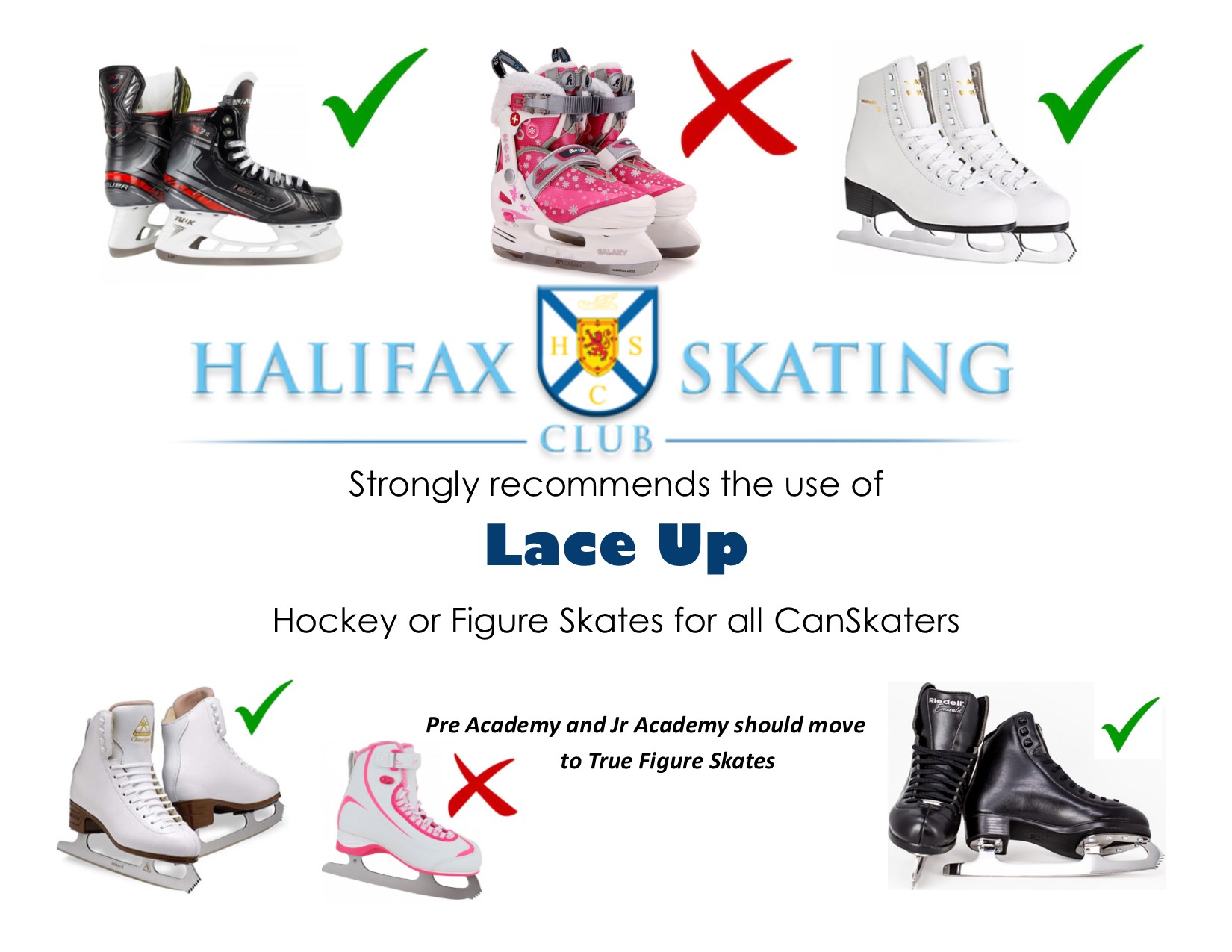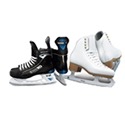

Equipment
Proper equipment is essential to becoming skilled in most sports and skating is no exception! Skaters cannot learn skills unless their skates fit well and support their ankles. If your child cannot walk across the floor holding his/her ankles up it is highly unlikely that he/she will be any better on the ice.
It is important to remember that learning to skate should be a fun and successful experience. It should not be lessened by poor quality equipment or physical discomfort. A well thought out purchase of good skates will encourage enthusiasm and excitement in anyone learning to skate.
If at anytime you have questions or concerns regarding your equipment, please consult with any of the Club coaches. A skate Check will be performed during the first view weeks of classes to ensure skaters have the best equipment for success.
Good Quality CanSkate level equipment can be purchased locally at any sporting goods store, like Sport Check, Cleve's Source fro Sports etc. All PreCan level skaters MUST have a face shield to protect during front facing falls
Skates
A variety of local stores sell skating equipment in a variety of price and quality ranges. Before buying skates, check carefully for:
- Proper fit
- Firm Ankle support
- Laces and hooks, not buckles
- Good quality leather (no plastic)
Avoid buying larger size skates for skaters to “grow into”. If you buy children's skates too loose, they will interfere with the skating and may actually be dangerous because of lack of support.
How to ensure correct size of skates
- Wear only one pair of socks or tights (the same pair that will be worn when skating)
- Partially unlace boot through instep
- Slide foot forward so toe can touch the front but not cramped
- Stand with weight equally distributed over both feet—bend knees
- The space at the back of the heel should be no more than a pencil width
- Don't forget to check if the width of the skates fit the foot—they should be snug but comfortable.
- Walk around in the skates off the ice; they should feel comfortable.
How to tie skates
- Once foot is placed comfortably in the boot…
Be sure the tongue is centered and pulled all the way up. - Start at the toe of the skate and tighten laces comfortably over the toe and front of the boot
- Before tightening the hooks, wiggle your toes to make sure the skates feel comfortable.
- Tie laces snugly around the ankle and tie a tight bow or double knot. Do not wrap laces around the ankle. If you feel you need to do this for more support, you probably need a new pair of skates!
- Make sure extra lace is tucked away. If the laces are too long, just cut them.
HSC CanSkate - How to select and tie skates.pdf
Sharpening your skates
All new skates and skates that have not been skated on for a month will need to be sharpened before you skate on them. Re-sharpen skates after approximately 20-30 hours of skating. More frequent sharpening may be required, if the skater walks on concrete, rubber or carpeted surfaces without guards, if the blades are not wiped dry, or if there are severe nicks and rough surfaces on the edges of the blade.
Do NOT remove the bottom pick on figure skates. The pick is part of the design of figure skates and is essential to proper balance.
Helmets
Helmets are mandatory for all skaters in the Pre CanSkate and CanSkate programs and MUST be CSA approved! Bike Helmets are not permitted.
Helmets should fit snug and both the helmet and strap should be adjustable.
Care of Equipment
Always wear protective guards when not on the ice. Do NOT walk on concrete surfaces without skate guards. Sharpening and blades will wear much faster, and are damaged severely by the surface.
After a lesson, dry blades and sole plate completely with a cloth. This will prevent the blades from rusting. Always remove guards and allow skates to air dry completely after each skate.
When not in use, remove skates from the skate bag and leave them in the open so that they can air dry thoroughly, allowing the leather to breath.
Skating Clothing
The rink is cold so remember to bring extra clothing and layer when possible.
Pants/Jackets - To keep your child warm, snow pants or windbreaker pants over long pants are recommended. Sweaters and turtlenecks or a winter jacket on top should be sufficient. Try to avoid clothing that is too bulky, restrictive or not waterproof.
Mitts/Gloves – Bring at least 1 pair of warm gloves each day and have a back up pair in case they get wet. Put a few pairs of gloves in the skating bag at the beginning of the season and you won't have to remember to bring them each time.
